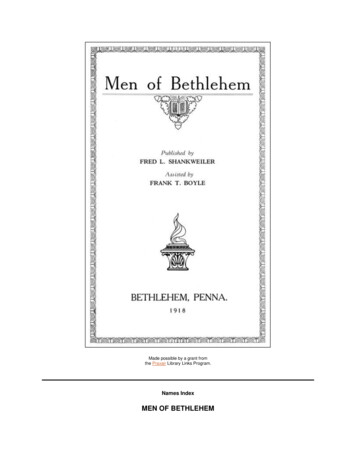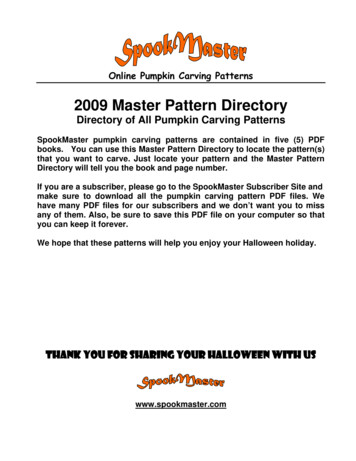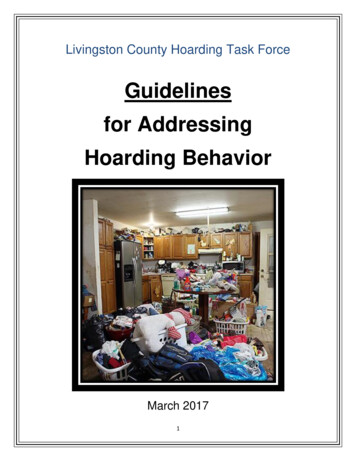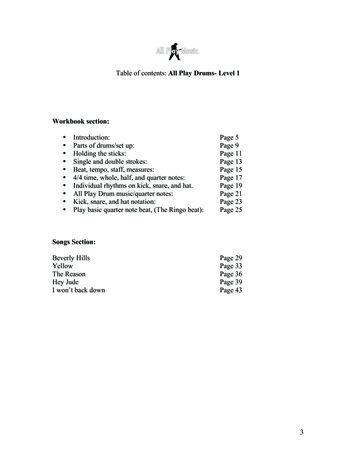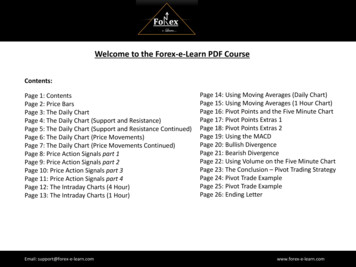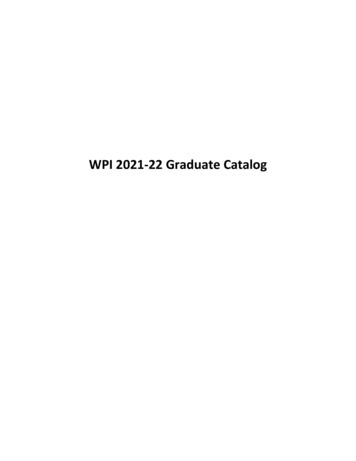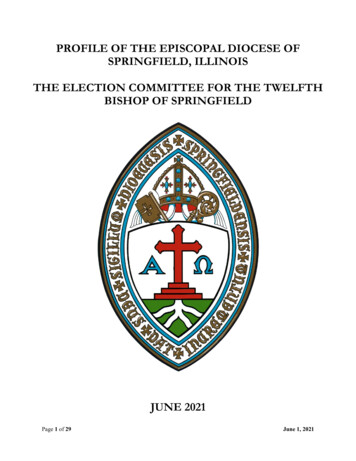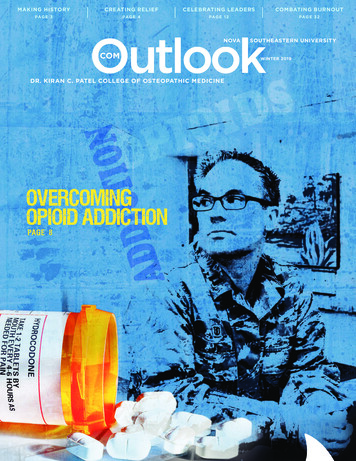
Transcription
MAKING HISTORYCREATING RELIEFCELEBRATING LEADERSCOMBATING BURNOUTPAG E 3PAG E 4PAG E 1 2PAG E 3 2OutlookNOVACOMDR. KIRAN C. PATEL COLLEGE OF OSTEOPATHIC MEDICINEOVERCOMINGOPIOID ADDICTIONPAG E 8SOUTHEASTERN UNIVERSITYWINTER 2019
TABLE of ContentsFeatures04 Displaced by DisasterINNOVATIVE WEBSITE OFFERS INSPIRING SOLUTIONFOR DISASTER-RELIEF HOUSING0806 One Year After MariaBACK-TO-SCHOOL DRIVE AIDS SEVEN PUERTO RICOCOMMUNITIES FOLLOWING DEVASTATING 2017 HURRICANE08 Beating Addiction2006 ALUMNUS SHARES HARROWINGSTORY OF OPIOID DEPENDENCE12 Stanley Cohen and Arnold MelnickCELEBRATING THE LIVES OF TWO ESTEEMED LEADERS22 From Trauma to TriumphSPORTS MEDICINE CLINIC’S MULTIDISCIPLINARY12APPROACH SPEEDS RECOVERYDepartments01 Editor’s Exchange02 HPD COMmuniqué03 COM NewsDUAL D.O./M.D. WHITE COAT CEREMONY MAKES U.S. HISTORY2226 Faculty Spotlight30 Student acCOMplishments32 Student Perspectives38 Alumni Corner40 Alumni Spotlight4446 Closing NotesCover illustration by Richard Kobs, Graphic Designer, NSU Office of Publications and Creative Services
OutlookCOMEDITOR’S ExchangeWINTER 2019 VOLUME 19, NUMBER 3COM Outlook is produced byNOVA SOUTHEASTERN UNIVERSITYDr. Kiran C. Patel College of Osteopathic Medicine3200 South University DriveFort Lauderdale, Florida eopathicNOVA SOUTHEASTERN UNIVERSITYGeorge L. Hanbury II, Ph.D.President and Chief Executive OfficerHEALTH PROFESSIONS DIVISIONFrederick Lippman, R.Ph., Ed.D.Chancellor/Special ProjectsIrving Rosenbaum, D.P.A., Ed.D., M.P.A.Vice President for OperationsDR. KIRAN C. PATEL COLLEGE OFOSTEOPATHIC MEDICINEElaine M. Wallace, D.O., M.S.4DeanEXECUTIVE EDITORScott Colton, B.A., APRHPD Director of Medical Communicationsand Public Relations(954) 262-5147 scottc@nova.eduASSOCIATE EDITORDebra R. Gibbs, B.A.Medical Communications Coordinator(954) 262-1545 dgibbs1@nova.eduART DIRECTORSusan Tischenkel-Hayward, Associate Director/Senior Graphic Designer, Office of Publicationsand Creative ServicesOFFICE OF PUBLICATIONS ANDCREATIVE SERVICESBernadette Bruce, DirectorSheryl Koral, University EditorCarol Reynolds-Srot, Associate Editor/CopywriterRoberta Harris-McCafferty, Production ManagerNova Southeastern University is accredited by the SouthernAssociation of Colleges and Schools Commission on Collegesto award associate’s, baccalaureate, master’s, educationalspecialist, doctorate, and professional degrees. Contact theCommission on Colleges at 1866 Southern Lane, Decatur,Georgia 30033-4097 or call 404-679-4500 for questionsabout the accreditation of Nova Southeastern University.Nova Southeastern University admits students of any race,color, sex, age, nondisqualifying disability, religion or creed,sexual orientation, gender, gender identity, military service,veteran status, or national or ethnic origin to all the rights,privileges, programs, and activities generally accorded ormade available to students at the school, and does not discriminate in administration of its educational policies, admissions policies, scholarship and loan programs, and athleticand other school-administered programs. Any such actsare unacceptable and strictly prohibited by the university.10-025-18SATThis issue of COM Outlook marks anexciting milestone for the Dr. Kiran C.Patel College of Osteopathic Medicine(KPCOM), as well as for me. Incredibly,this issue launches the 20th anniversaryyear of the magazine’s establishment—and my 20th year as a proud Nova Southeastern University (NSU) employee.When I joined the KPCOM in 1999, oneof the first tasks I was charged with was creating a magazine for thecollege—an incredibly exciting, but daunting challenge. Thanks tothe collegiality and contributions of my colleagues, as well as thealumni and students, the magazine evolved into an award-winningpublication that has received more than a dozen national accoladessince its inception.In my role as the unofficial historian for the college and the HealthProfessions Division, it has been a privilege to document the KPCOM’sgrowth in size and esteem over the years. During the magazine’searly years, the college consisted of only the Doctor of OsteopathicMedicine program. Today, the KPCOM has eight degree programs,including the recently established Bachelor of Science in HumanNutrition, which will matriculate its first class in the fall of 2019.As both COM Outlook and I launch our 20th year at NSU, thisissue serves as a bridge to both the past and the future. In July, theKPCOM lost two of its iconic leaders with the passing of its founding dean, Arnold Melnick, D.O., M.Sc., FACOP, and Stanley Cohen,Ed.D., M.Ed., who had been affiliated with the college since 1980.To honor their innumerable accomplishments, we take a fond lookat their careers and legacies.One of the many joys of producing COM Outlook is the compelling stories we get to tell about the wonderful KPCOM family ofstudents, faculty and staff members, and alumni who continuallycontribute to the college’s success. In this issue, a brave alumnusshares his harrowing story of battling his demons to overcome acrippling opioid addiction. Conversely, we spotlight another alumnus who experienced the joy of winning a 2018 Tony Award for hiswork as a Broadway producer.Sprinkled throughout this issue are spotlights on the college’sprogressive Sports Medicine Clinic, enlightening student perspectivepieces, heartfelt community service efforts, and general news aboutthe people and programs that are an integral part of the rich KPCOMfabric. Thankfully, there is never a dearth of topics for us to write about.Here’s to the next 20 years.Scott Colton, B.A., APRHPD Director of Medical Communications and Public RelationsNova Southeastern UniversityNOVA SOUTHEASTERN UNIVERSITY 1
HPD COMmuniquéWhen Morton Terry,D.O., establishedSoutheastern Collegeof Osteopathic Medicine—theforerunner to Nova SoutheasternUniversity’s Dr. Kiran C. PatelCollege of Osteopathic Medicine—in 1979, who could have imaginedwhat this formidable, visionaryfigure would accomplish over thenext few decades?Dr. Terry’s great foresight wouldlead to the creation of additional colleges, the founding of Southeastern University of theHealth Sciences, and, eventually, the establishing of NSU’s Health Professions Division. Hisdream was to develop an educational environment that was not only interdisciplinary, butalso collaborative concerning the delivery of health care.Today, the Health Professions Division is the ultimate culmination of Dr. Terry’s intuitionand vision—a progressive and prosperous health education system made up of 8 colleges andmore than 60 degree and certificate programs. Because of Morton Terry and many otherswho helped pave the way, we were able to create a synergistic health education system thatproduces thousands of health care professionals on a continuum to care for the residents ofthe United States.From a nationwide perspective, the NSU Health Professions Division has been a truetrendsetter. We have, and continue to, set the example for many established and neweruniversities, including my alma mater, Columbia University, as well as the University ofChicago and Lincoln University, which are all creating their own versions of our HealthProfessions Division.Nova Southeastern University has earned its reputation as an esteemed educationalinstitution. If you look at the alumni from our various programs, you will find themworking in assorted and important roles throughout the United States. Some are serving asdeans, chairs, and directors at prestigious universities, while others are working as smalltown health care providers or delivering care at large teaching hospitals.NSU has grown and evolved since its 1964 inception, and its 1994 merger with SoutheasternUniversity of the Health Sciences, by adopting the core values and principles of preeminenteducation. As a result, NSU is being recognized for its all-encompassing excellence, whichbrings added value to the degrees our graduates earn during their broad-based educationaland clinical training.It may be a bold prediction, but I think that within the next 5 to 10 years, NSU will rank asone of the top 100 universities in the United States.Frederick Lippman, R.Ph., Ed.D.ChancellorHealth Professions Division/Special Projects2 DR. KIRAN C. PATEL COLLEGE OF OSTEOPATHIC MEDICINE
COM NewsDual D.O./M.D. White Coat CeremonyMakes U.S. HistoryOn July 28, Nova Southeastern University madehistory by hosting the first combined D.O./M.D. WhiteCoat Ceremony in the United States. NSU is one ofonly three universities in the country with two medical colleges. Both of NSU’s medical colleges bear thename of Dr. Kiran C. Patel.The White Coat Ceremony served as the officialwelcome for both the charter class of 53 M.D. students and the more than 240 D.O. students who areenrolled in NSU’s two medical colleges. The university is home to Broward County’s only D.O. and M.D.programs, and the Dr. Kiran C. Patel College ofOsteopathic Medicine (KPCOM)—the largest medical college in Florida—offers one of only two D.O.programs in the state. Thirty-four osteopathic collegesare accredited to deliver instruction at 51 teachinglocations in 32 states.Ceremony highlights included keynote addressesfrom medical leaders Tyler Cymet, D.O., FACP,FACOFP—a 1988 KPCOM alumnus who serves aschief of clinical education for the American Association of Colleges of Osteopathic Medicine—andDarrell G. Kirch, M.D., president and CEO of theAssociation of American Medical Colleges.“We are facing a physician shortage, which will havedrastic effects on the future of health care, our economy,and our collective well-being,” Cymet said. “NSU’s focuson educating health care professionals on the importance of interprofessional respect and understandingprovides its students with an edge in the real world.”To meet demands in its medical, health care, andlife science programs, NSU is planning to construct a250,000-square-foot, integrated medical educationbuilding on its Fort Lauderdale/Davie Campus, inaddition to opening its Tampa Bay Regional Campusin Clearwater, Florida.“NSU is making a major investment in health andhealth education for the betterment of our society,” saidGeorge L. Hanbury II, Ph.D., NSU president and CEO.“This will spark major growth and opportunity withNSU’s projected 5-billion economic impact in Floridaby 2020 and help bring us one step closer to being anationally recognized, top-tier university of teaching,research, service, and learning.” NOVA SOUTHEASTERN UNIVERSITY 3
RETSDISAYBDECALDISPINNOVATIVE WEBSITE OFFERS INSPIRING SOLUTION FOR DISASTER-RELIEF HOUSINGBY SCOTT COLTON, B.A., APRIn her role as dean of the Dr. Kiran C. Patel Collegeof Osteopathic Medicine (KPCOM), Elaine M. Wallace,D.O., M.S.4, exemplifies the NSU Core Value of studentcenteredness. A recent example of her continued commitment to student health and wellness was evidencedby the creation of an important website that can benefitstudents attending Florida’s various medical schools.In October 2016, Wallace presented an innovativeidea to the Council of Florida Medical School Deans(CFMSD). Her suggestion focused on the importanceof creating a network of medical students who wouldbe willing to temporarily house other Florida medicalschool students displaced by natural disasters.“Several medical schools throughout the southeastern and southern United States have been impactedby natural disasters in recent years. The schools hadarrangements in place for holding classes at alternatesites, but not much was mentioned about the displacement of students,” said Mark Sandhouse, D.O., M.S.,associate dean of administration, who chaired theCFMSD task force charged with exploring the idea.“The creation of the Florida Medical Student Disaster Housing program addresses the human componentof a natural disaster in Florida,” he added. “It givesstudents of all the Florida medical schools the abilityto find a safe haven during and after a storm, shouldthey need it.”Working with physicians from Florida State University (FSU) and the University of Miami, as well aswith student representatives from the Florida MedicalAssociation and the Florida Osteopathic Medical Association, the task force designed a registration questionnaire for interested students. FSU—in a display ofappreciated collaboration—also volunteered to createand host the website.As task force chair, Sandhouse led brainstormingsessions to develop methods for student registration,4 DR. KIRAN C. PATEL COLLEGE OF OSTEOPATHIC MEDICINEas well as for local administration and informationdissemination, in the event of a disaster. “The development took place in phases, with the initial questionnaire created on a public platform,” he said. “I developed the list of local administrator responsibilities andled the rollout of the final product, first to the localadministrators, and then to the entire CFMSD group.”After nearly two years of intricate planning, theconcept morphed into reality with the official debut ofthe Florida Medical Student Disaster Housing websiteon July 27, 2018. “The task force members are excitedabout the opportunity we created for our students,”Sandhouse said. “As a result, we are looking to furtherdevelop the site and have it serve as a model for medical schools throughout the United States.”KPCOM students interested in participating in thisworthy program can register to house a Florida medical student at fmsdisasterhousing.com.
“The creation of the Florida Medical Student Disaster Housingprogram addresses the human component of a natural disaster inFlorida. It gives students of all the Florida medical schools the abilityto find a safe haven during and after a storm, should they need it.”—Mark Sandhouse, D.O., M.S.FLORIDA MEDICAL STUDENTDISASTER HOUSINGCREATORElaine M. Wallace, D.O., M.S.4TASK FORCEMark Sandhouse, D.O., M.S., CFMSD Task Force ChairCouncil of Florida Medical School DeansFlorida State University PhysiciansUniversity of Miami PhysiciansFlorida Medical Association Student RepresentativesFlorida Osteopathic Medical Association Student RepresentativesNOVA SOUTHEASTERN UNIVERSITY 5
One YearAfter MariaBACK-TO-SCHOOL DRIVE AIDS SEVEN PUERTO RICO COMMUNITIESFOLLOWING DEVASTATING 2017 HURRICANEBY SCOTT COLTON, B.A., APR“Working together with otherdonors, our contributionshelped more than 150 children,which I am so thrilled about.”—Evelina Arzanova, M.B.S.6 DR. KIRAN C. PATEL COLLEGE OF OSTEOPATHIC MEDICINEHelping those in need has long been a hallmark ofthe Dr. Kiran C. Patel College of Osteopathic Medicine,which has coordinated dozens of medical outreach tripsto various underserved areas throughout the world overthe past two decades.During the first half of 2018, the KPCOM organizedtwo separate medical outreach trips to various communities in Utuado, Puerto Rico, to assist the many residentsaffected by Hurricane Maria, which decimated the islandin September 2017. Because of the generosity of thosewho contributed various supplies to the humanitarianexcursions, the college’s medical outreach programcoordinator, Evelyn Martinez, came up with the ideato create a back-to-school supply drive for the sevencommunities the KPCOM visited. The seven communities aided were Mameyes de Utuado (clinic location);Mameyes de Jayuya; Limon; Don Alonso; Caonillas;Fronton de Ciales; and Tetuan 1, 2, y 3.“My involvement in the back-to-school drive began inMarch, during our first medical outreach trip to PuertoRico,” Martinez explained. “When second-year studentBetsy Rodriguez came to my office with multiple boxesof donations, including toiletries, school supplies,
backpacks, and reusable water bottles, I immediatelythought about the possibility of a back-to-school eventto benefit Puerto Rico.”Martinez and second-year students EvelinaArzanova, M.B.S.; Jennifer Lara; and Lorena Rodriguez collaborated to make the back-to-school drive areality. “Once we returned home, we put our planinto action,” Martinez said. Arzanova jumped in bycreating a GoFundMe account, which raised 1,185,while Lorena Rodriguez took charge of organizing asummer bake sale, which brought in about 400.“Working with Evelyn Martinez was instrumental in finding the best ways to utilize these funds,”Arzanova added. “We used the funds to purchasehygiene products, such as toothbrushes, razors,and toothpaste, as well as T-shirts. We also helpeda few families in need by making a direct donationfrom the funds we raised.”Martinez also contacted various wholesalersto obtain quality backpacks for the children andpurchased school supplies in bulk. “Once all thesupplies were collected, we got together as a teamto get everything ready for shipment,” she said.Although preplanned, other KPCOM commitments prevented Martinez and her team of studentsfrom traveling to participate in the August 11 backto-school event. KPCOM alumna Eileen Soto, M.D.,M.S., who graduated with honors from the college’sMaster of Science in Nutrition program in May, wasproud to stand in and represent the college.“Working together with other donors, our contributions helped more than 150 children, which Iam so thrilled about,” Arzanova said. “We couldnot have done this without working as a team andhaving a desire to truly make a difference.” Children displaythe items theyreceived fromthe KPCOM.
BEATINGADDICTION2006 ALUMNUS SHARES HARROWING STORYOF OPIOID DEPENDENCEBY SCOTT COLTON, B.A., APR8 DR. KIRAN C. PATEL COLLEGE OF OSTEOPATHIC MEDICINE
Left to right: J Foster Chapman celebrates receiving his KPCOM acceptance letter in 2002; his 2006 graduation photo; Chapman attends a militaryphysician’s conference in New Orleans, Louisiana, in 2011.the topic of drug addiction has been the theme of countless books, movies, and documentaries—and for goodreason. Everyone from world-famous celebrities toordinary citizens has battled, overcome, or succumbedto his or her compulsions. It’s a universal topic thathas impacted, and continues to impact, the lives of allthose involved.While the origins of drug addiction can be linkedto many factors, one thing is certain: It’s a uniquelypersonal experience that causes despair for those closeto the users and wreaks personal and professionalhavoc on the addicts themselves. Just ask J FosterChapman, Sr., D.O., a 2006 NSU Dr. Kiran C. PatelCollege of Osteopathic Medicine (KPCOM) graduate.Chapman, a recovering opioid addict, grew up ina poor South Florida community. Drugs were commonplace in his neighborhood, as well as in his home.“My next-door neighbor’s place and the apartmentcomplex across the street were crack houses,” he said.I’ve woken up to find men I didn’t know, who werepassed out and bloody from a fight, on my front yardor on my bedroom floor. There was so much marijuana around that I honestly didn’t know pot wasillegal until my father sat me down and told mewhen I was about 10 years old.”It seemed to Chapman that everyone in his childhood universe was abusing drugs, and so he begansmoking pot at age 12. An addictive personalitycompounded the problem, he added. “I believe thatI was born this way. Looking back on my pre-usingchildhood, I was already displaying addict behavior.”Despite his less-than-idyllic childhood, Chapmanknew from an early age that he wanted to pursue acareer in medicine. “I became interested in medicinefrom my mom, a registered nurse who worked in agastrointestinal lab,” he explained. “She would takeme to work with her if she couldn’t find a babysitter.By the age of five, I could name the entire gastrointestinal tract.”Several years later, a ride in a physician’s Lexusintensified his intention to attend medical school.“We didn’t always have enough food to eat,”Chapman said. “I used to dig through dumpsters forspare change and scavenge for aluminum to recycle.That’s why being in the presence of moderate luxury,like a ride in a Lexus, was such a seminal moment inmy childhood. I got to see how ‘the other half’ lived,so that 20-minute car ride changed my life.”“There was so much marijuanaaround that I honestly didn’t knowpot was illegal until my father satme down and told me .”—J Foster Chapman, Sr.Although his goal of becoming a physician was acomforting plan to escape the misery of his youth,Chapman knew he was sabotaging his chances ofgetting into medical school by smoking copiousamounts of weed. “Once I realized I wouldn’t reachmy goal of becoming a physician if I didn’t changemy behavior, I abstained from smoking pot untilI went to college.”After earning his A.A. degree from Palm BeachCommunity College in Palm Beach Gardens, Florida,and his B.S. in Microbiology and Cell Science fromthe University of Florida in Gainesville, Chapman embarked on his medical school career at NSU-KPCOM.Drug Woes WorsenThe hiatus did not last. By the time he began attending KPCOM classes in 2002, Chapman was a selfdescribed “functional addict” who was smoking potand drinking during the school week and engaging inNOVA SOUTHEASTERN UNIVERSITY 9
From left in early 2010: K Rose (daughter), Stefanie (wife), J Foster, Jr. (son), and J Foster Chapman, Sr.much riskier behaviors on the weekends, includingingesting cocaine, LSD, and MDMA (commonlyknown as ecstasy or “Molly”).Not surprisingly, Chapman’s academic prowesssoon diminished. “I earned a 66 on my first anatomyexam and failed psychiatry in the second year. I almostgot kicked out of school,” he said. “I based my rotationson if they drug tested or not.” Trapped in a cycle ofdrug abuse—and in danger of squandering everythinghe had worked so hard to attain, Chapman said he didthe bare minimum to get by.After graduating from the KPCOM in 2006, he sethis sights on a military career with the United StatesAir Force (USAF). “I knew they drug tested in themilitary, so I decided to stop doing drugs, althoughI continued to drink heavily,” he said. As a memberof the Air Force Reserve, Chapman spent three yearsdoing his family practice residency at St. Vincent’sMedical Center in Jacksonville, Florida.Disaster struck midway through, however, when hisfather unexpectedly passed away, sending him spiraling into an orgy of opioid use. “Despite being a poorrole model, my father was my best friend. I was devastated when he died,” said Chapman. “I made a conscious decision to start using my Drug EnforcementAdministration license to obtain narcotics to numbthe pain. Suddenly, opioids became my whole world.I quickly got hooked, and by the time I entered theUSAF for active duty in 2009, I was barely functioning.”Chapman’s USAF appointment as medical directorat the Barksdale Air Force Base in Louisiana shouldhave been an exciting professional milestone. Instead,10 DR. KIRAN C. PATEL COLLEGE OF OSTEOPATHIC MEDICINEhis life was unraveling before his eyesas he pilfered pills and forged prescriptions to feed his now raging opioidaddiction. “When 40 Percocet tabletsdidn’t get me high anymore, I startedinjecting Opana , Dilaudid , Demerol ,and morphine.“My life was spiraling out of control,”Chapman said. “I was hospitalizedthree times for cellulitis, and I almostlost my left leg. I was even shooting upcrushed pills I snuck into the hospital,”he disclosed with brutal frankness. “Iwas a worthless husband, father, andairman for the USAF.”Crippled by the agonizing withdrawalsymptoms that accompanied his futileefforts to go cold turkey, his addictionraged unchecked. “I was simply tooashamed to ask for help,” he admitted.The High Price of Getting HighChapman’s risky behavior and impaired decisionmaking eventually caught up with him. In 2013, it setoff a confluence of events that resulted in a militaryinvestigation. “I was removed from patient care andforbidden from prescribing anything to anyone,” Chapman said. “Suddenly, my opioid supply was eliminated.”To satisfy his intense cravings, Chapman resortedto buying pills on the street. As he continued hisperilous descent toward rock bottom, he concocted astrategy to end his life. “I became suicidal and wrotegoodbye letters,” he admitted. “While writing thefinal letter to my daughter, I was touched by a spiritual presence that forced me to step back and examineexactly what I was doing. This ‘moment of clarity’allowed me to finally ask for help.”In February 2014, Chapman entered a rehab facility for a four-month stay. By the time he left in June,however, the sobering repercussions of his prolongedcriminal activities loomed large. “When I got out ofrehab, I was court-martialed and pled guilty to variousdrug-related charges,” he acknowledged.What followed was a demoralizing 212-day stay in aCharleston, South Carolina, military prison that testedthe limits of Chapman’s sanity. “Prison was the best,and worst, thing that has ever happened to me. Beingstripped of my status, my profession, and my familyliterally broke me as a human being,” he said. “I hadto have everything taken from me to appreciate howblessed I already was. Halfway through my sentence,my depression, along with my obsession to use, finally
lifted. I became happy again. I thought, ‘If I can behappy in here, sober, with nothing, maybe I can behappy on the outside as well.’ ”Staying Clean: A Daily ProcessOne of the first things Chapman had to dealwith when he was released from prison was makingamends with his family, which included his wife,Stefanie, whom he met in high school, and his children K Rose; J Foster, Jr.; and Bernard Samuel. “Mywife single-handedly held our family together throughmy addiction, my incarceration, and my recovery,”he said. “I owe her my life.”The road to being—and remaining—clean is pavedwith obstacles, which is why Chapman is determinedto avoid the pitfalls and do whatever is necessary toremain drug free. “Only dead people beat their addiction; I just haven’t used today,” he explained. “I amfour years through a five-year program for impairedproviders and am subject to random drug testing.”“My wife single-handedlyheld our family together I owe her my life.”—J Foster Chapman, Sr.Chapman attends twice-weekly Narcotics Anonymous meetings, visits a therapist twice monthly,participates in weekly Caduceus meetings, and seesan addictionologist quarterly. He also speaks to addictsat various recovery centers. “Telling my story to streetlevel drug addicts and prostitutes seems to reach themon a special level,” he explained. “They say, ‘Wow! Adoctor? You did all that?’ I think it helps them understand that addiction truly is a disease. It also helpskeep me grounded, since I know what’s waiting forme if I relapse.”Because of his criminal record, restarting hismedical career took time, said Chapman, who is theprimary care manager of the Traumatic Brain InjuryClinic at Fort Polk in Leesville, Louisiana. “I enjoyhelping our brave soldiers recover from their traumaticbrain injuries,” he said. “Some of them have also dealtwith alcohol and drug addiction. My experiences allowme to relate to them on a truly unique level. I canlook them in the eyes and say, ‘I understand; I’vebeen there. And I can help you get out.’ ”After years of drug dependency, and dealingwith the altered behaviors and perceptions thataccompany addiction, Chapman is relishing hisrecovery and the steps he is taking to stay clean.“I can’t verbalize how wonderful being clean is,”he said. “I’ve never been happier.” 10 PIECES OF ADVICEBY J FOSTER CHAPMAN, SR.Addiction is the only disease I know of thattells you that you don’t have it.Repeat after me.1. If you think you might have a problem,you do.2. If you think you have it under control,you don’t.3. If you think you can stop and recoveron your own, you can’t.4. Quitting is not the same as recovering.(Quitting is easy. I quit all the time.)5. You don’t have to steal from your kids.6. You don’t have to falsify prescriptions.7. You don’t have to become a junkie, behospitalized, or lie to everyone you love,including yourself.8. You don’t have to go to prison.9. Asking for help will not negatively affectyour career.10. The people in your life, personally andprofessionally, want you to succeed. Iwant you to succeed!Learn from my mistakes. Ask for help today.The Henderson Student Counseling Center is available to all NSU students whomay be dealing with anxiety, chronic illnesses, financial stress, social struggles,substance abuse and addiction, suicidal thoughts, or other issues.24/7 HOTLINES: (954) 424-6911 or (954) 262-7050WEBSITE: eling.htmlNOVA SOUTHEASTERN UNIVERSITY 11
“Dr. Melnick, along with Dr. Morton Terry, was aformidable figure in the creation of the 15th osteopathic medical school in the United States and theestablishment of Southeastern University of theHealth Sciences. It was his belief that health careshould be designed for the purposes of providingas much care, and as much knowledge of illnessprevention, to the many students who were comingthrough the institution, and then providing qualityhealth care to the community at large. He was someone I learned a great deal from about the academicand technical elements of the creation of the variousunits of Southeastern University of the HealthSciences, which is now known as the NSU HealthProfessions Division.”—Frederick Lippman, R.Ph. Ed.D.,Chancellor of the Health Professions Division/Special Projects“Dr. Stanley Cohen was one of the most unique andwarmhearted men I ever met. He always had a jokeand an understanding of feelings. His love of theschool was worn on his sleeve with great pride, andhe always worked for its betterment. His warmth andhumanity were always obvious, along with his love ofthe students. Stan will always be an icon, and his influence on many of us will be a major part of his legacy.”—Anthony J. Silvagni, D.O., Pharm.D., M.Sc., FACOFP dist., FCPP,KPCOM Dean Emeritus and Director of International Medicine“The 30-year journey we shared was filled with mutualrespect, moral support, and a common passion for thewell-being of children. Dr. Melnick was a mentor and afami
SPORTS MEDICINE CLINIC'S MULTIDISCIPLINARY APPROACH SPEEDS RECOVERY Departments 01 Editor's Exchange 02 HPD COMmuniqué 03 COM News DUAL D.O./M.D. WHITE COAT CEREMONY MAKES U.S. HISTORY 26 Faculty Spotlight 30 Student acCOMplishments 32 Student Perspectives 38 Alumni Corner 40 Alumni Spotlight 46 Closing Notes 08 12 22 44



